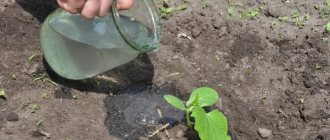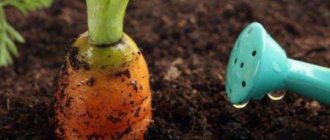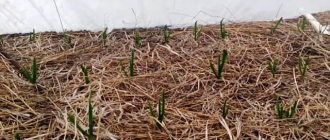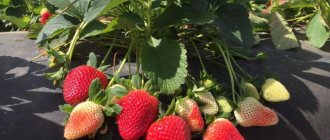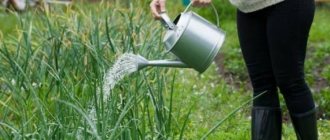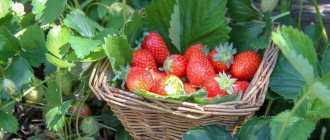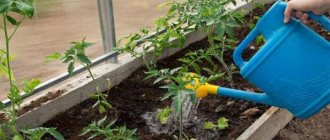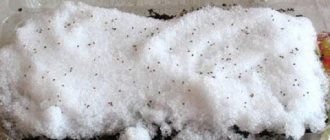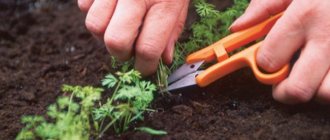Watering is the most important agricultural technique.
It seems that there is nothing complicated about it. But, in fact, there is a certain irrigation regime for each plant, which saturates the roots with moisture to the proper extent, but does not over-moisten the soil. This time we will talk about watering strawberries, the frequency and features of this procedure. Dear readers! For you, we have created communities on social networks in which useful articles and interesting ideas are published several times a day! Subscribe and receive useful content in a convenient format!
What determines the frequency of watering strawberries in open ground?
The frequency and volume of water during the procedure depend on several factors. The most important thing is the climate of the region. In dry areas, the plant needs to be watered more often to prevent it from drying out.
The second important point is the type of soil. On heavy soils, you need to water less often, since water stays in such soil longer.
The variety of strawberry also affects the amount of moisture needed by the bush.
Sprinkling strawberries
A sprinkler irrigation system can be a mobile unit that can be moved to other fields, or it can be permanently installed, with some parts placed underground. Therefore, site selection is a major decision if irrigation is used for subsequent crops.
Placing sprinklers in a triangular checkerboard pattern covers the area more reliably than placing them in squares. As a rule, sprinklers are placed no further than 12...15 m from each other, for uniform watering, taking into account winds of up to 16 km/h. A distance of more than 15...18 m usually does not give positive results. The most commonly used nozzles are 1.2 cm (about 0.3 cm per hour) and the pressure on the sprayer is about 9 kg/cm2. Larger nozzles may be necessary. The water flow should be about 500 liters per minute per hectare to obtain 30 mm. at one o'clock.
What temperature should the water be and can I use cold water?
The ideal water temperature for strawberries is about 20 degrees. The liquid must be settled and clean. You cannot use water directly from a well or water supply. Because of it, strawberries develop diseases, the number of fruits and their taste noticeably decrease.
At the same time, the water should not be allowed to overheat. 40 degrees is already too hot for berries. Therefore, keep the container in the shade.
What to water
This plant requires fertilizing throughout the growing season. That is, in spring, summer and autumn, only with different fertilizers.
Spring and summer
- In the first year of life, the bushes are not fed - because when planting them, you should have already applied a complex of fertilizers.
- In the second year, after the first new leaves appear, chicken compost or mullein is added.
- Carry out foliar feeding by spraying the bushes with an organic solution or nitrogen fertilizers. This spraying is done in the evening, when there is no wind.
- Feeding with mineral fertilizers. The last feeding is done already during the formation of the ovaries, and best of all - an infusion of crushed weeds fermented in water. They are infused in a warm place for a week.
- Before strawberry seedlings begin to flower, a sprinkler method of watering is allowed, which will not only saturate the soil with moisture, but also wash the leaves from dust.
- By the end of August it should be fertilized with nitrogen-containing fertilizers.
The flowering time after transplanting should be checked with your seed supplier (usually late April - early May). This is done so as not to apply fertilizer ahead of time. In this case, they will go aimlessly into the ground, be washed away by watering or rain, and will not enter the root system in the required quantity.
Autumn
Instructions for fertilizing strawberries before wintering:
- You should add more potassium fertilizers and limit the strawberry diet to nitrogen fertilizers - they are the ones that form the leaf mass; it is not needed by winter.
- But the first feeding, at the end of August, is still done with nitrogen-containing urea. But the second, in the second half of September, with mullein. It will ensure the laying of fruit buds for the next season.
Fertilizer table
The seasonality table for fertilizing is presented below.
How to water strawberries against weevils
Main article: How to get rid of weevils on strawberries
Folk remedies:
- Ash solution (per 8 liters 0.45-0.5 kg).
- Ammonia (10 ml per bucket).
- Mustard solution (0.1 kg per 3 liters of water).
In case of severe damage, strawberry beds are sprayed with chemicals:
- insecticides (Vofatox, Inta-Vir, Metaphos, Iskra, etc.);
- biological products (Fitoverm, Nemabakt, Antonem, Akarin, etc.)
How to pour ammonia
Ammonia in this case serves as a source of nitrogen for plants. Due to its pungent odor, it also repels harmful insects.
- For fertilizing, take 1 tbsp as nitrogen. spoon 25% alcohol and diluted in 1 liter of water.
- For seedlings, take 1 teaspoon of ammonia and 1 liter of water.
How often to water strawberries in different growing seasons
Now let’s look in a little more detail at the volumes of liquid required by the berry during different growing seasons.
How to water strawberries in the spring before flowering
From about the beginning to the end of May (depending on when your strawberries begin to bloom), the plant is watered several times. The sprinkling method is used. Water is poured every week. It is very important that the liquid saturates the soil well. Do not forget that you must weed the beds and loosen the soil.
Watering strawberries during flowering
Watering during flowering is carried out every 1.5-2 weeks. If the weather is good, then you don’t have to water the strawberries. In dry weather, on the contrary, you need to water every 3 days.
During the flowering period, you need to pour water very carefully so as not to wash away the pollen with the flower. When it rains, the bush can be covered with film to protect the flowers from water droplets.
IMPORTANT! During flowering, you only need to water in the morning so that the soil under the strawberries dries out by night.
The approximate consumption rate during this period is a liter mug per bush.
How to water strawberries during the formation of ovaries
During the ovary formation phase, it is very important that irrigation is regular. Neither periods of drying out nor periods of waterlogging should be allowed. Both cases will lead to the ovaries falling off, and you will simply be left without a harvest.
Features of watering during fruiting
During active fruiting, strawberries are watered every week, adjusting the frequency and abundance of watering depending on precipitation.
It is advisable to mulch the beds so that moisture remains at the roots longer. Watering should be drip.
ADVICE. Before watering the beds, harvest ripe strawberries. They will not get dirt that a jet of water will create.
Watering after fruiting
When the fruiting period ends, the strawberries begin to prepare for the next season. Now you can pour water not only under the root, but also on the leaves.
Seasonal watering: when, how and how much to water?
Novice gardeners care for strawberries only until harvest, and then forget about the plants. In fact, after picking the berries, the next important stage begins - the formation of mustaches, flower buds and preparing the plant for winter. And the harvest next year depends on how good and timely watering the plant receives. Let us dwell in more detail on the features of watering in different seasons.
Spring
Schedule for preparing and carrying out spring watering:
- Before watering, remove any old mulch from your strawberries.
- Check the soil to see if it is dry - if the winter was light with little snow, then watering is necessary.
- A couple of weeks after the snow melts, pour hot water over the strawberries - pour boiling water from a watering can from a height of 1 m over the strawberries and the soil between the bushes.
From this height, the water will have time to cool a little (about 60-70 degrees) and will not harm the strawberries. 1 bush requires about 500 ml of water, at a depth of 10 cm, at the roots, the temperature will be about 30 degrees. Pests overwintering in the top layer of soil will be destroyed. After a week, this treatment with boiling water can be repeated. But this is done only in early spring, before the strawberries begin to grow, since young shoots can get burned from hot water. - Since these plants have a superficial root system, from the moment they wake up they need water. Therefore, the sooner you start watering, the better the strawberries will develop.
- From late April to early May, strawberries are watered once every 6 days.
- In total, 2-3 abundant waterings will be needed in the spring.
- For spring watering, while there are no flowers on the bushes, the sprinkling method is suitable. At the same time, all dirt and dust are washed off from the leaves.
In the video below, the gardener talks about watering strawberries in the spring:
Be sure to weed out the weeds, otherwise they will block the strawberry roots from accessing water. And after watering, mulch the plants.
Summer
Watering is carried out as usual, during the fruiting period - abundantly 1-2 times a week.
By July, the temperature rises, and watering increases up to 3-5 times a week.
Autumn
After the harvest is harvested, strawberries need to regain their strength before winter. To do this, water it 2-3 times in the fall before the onset of cold weather. For 1 sq. m requires at least 20 liters of water. During the last watering, it is important not to over-moisten the soil, since in the event of a sudden frost, excessive moisture will lead to frostbite of the roots and the strawberries may die.
How to properly irrigate raised beds with strawberries
Raised beds, despite all their advantages, have one serious drawback. Water drains out of them very quickly. Therefore, strawberries planted in this way need to be irrigated very often. This is especially important on hot summer days, when the beds need to be moistened twice a day. It is extremely important to maintain temperature balance. The water should never be cold. The roots of strawberries growing in high beds get hotter, and adding cold water can become very stressful for the plant.
ADVICE. Mulch raised beds or use white agrofibre.
Morning or evening watering: how to do it right
Along with how much water needs to be poured onto the strawberry plantation and during what period of the growing season, an important indicator is the time of day at which watering is carried out.
Some gardeners are convinced that it is necessary to water the beds in the morning, while others claim that the ideal time for this procedure is the evening.
Correctly selected care in terms of providing strawberries with moisture is, first of all, reasonableness. It is from this that you must proceed when choosing the time for watering. So, in very hot weather, it is recommended to moisten the soil on the plantation in the evening. This will allow the roots to absorb as much water as possible. But even here there are exceptions: even if it is hot, and at the same time the strawberries have begun to bloom, it is better to water the plantings in the morning.
The fact is that slugs very often appear on flowering, and especially fruiting, garden strawberries. They are known to become active at night. High humidity is good for them. To avoid damage to plants by this pest, it is important to keep the beds in a relatively dry condition, that is, allow them to dry out before dark.
How to water strawberries after planting
Before planting, pour water into the planting holes and wait a little until the liquid is absorbed. Then plant bushes.
At first, the berries need to be watered quite often, but the volumes of liquid poured should be small. Your task is to maintain soil moisture, preventing it from drying out and at the same time not making it waterlogged. This way you will help the bush grow new roots.
ON A NOTE. Only planted strawberries can be watered by leaves in the first week. But this should only be done in the morning with the help of a watering can. The water pressure does not need to be strong.
After 10-15 days, the number of waterings should be reduced, but the volume of liquid increased.
Irrigation methods
Regularity and frequency of watering strawberries is important when growing a good, juicy crop. But the method of irrigation is no less important. There are three possible options for this plant crop - manual, drip or sprinkling methods.
Manual
It is convenient to water the garden with your own hands when there are several beds on it. You can do this using a watering can or hose connected to an automated water supply. Irrigation liquid can be stored in tanks or other large containers. It is better to pre-fill them and leave them to warm up to room temperature. The main advantage of this method is its low cost. But this method is not suitable for watering large plantations, as it requires human movement and is very labor-intensive.
Drip
It is convenient to irrigate berry bushes growing in open ground using the drip irrigation method. Its essence lies in the fact that thin tubes with small holes are laid across the fields, a ridge enters them with the help of a pump and is evenly distributed over the land plot. Among the advantages of this method, the following positive aspects can be highlighted:
- saving water resources, this is due to the fact that water is supplied in portions to each plant in small quantities;
- uniform watering, plants will not experience moisture deficiency, and the soil will never become waterlogged;
- the weeds will grow worse, some of them will dry out and die from lack of moisture;
- no puddles or slush form between the rows;
- The occurrence of burns on the green mass is excluded, even when watering in sunny weather.
See also Description and nuances of growing strawberries Zenga Zengana
But the drip method also has disadvantages. The creation of special pipelines requires a lot of effort and money.
Sprinkling
Another good way to water strawberries is sprinkling. It consists in the fact that with the help of a special apparatus, water is supplied, and through nozzles it is distributed into drops, after which it falls on the ridges, moistening the plants and penetrating into the soil. The effect is the same as that of rain, but it is created artificially. This method has several advantages:
- the system provides not only watering, but also air humidification, which will have a good effect on the growth of strawberries;
- relieves the plant of dust, due to which photosynthesis proceeds better and its rapid growth occurs.
But, you cannot water strawberries in this way during the day, since due to exposure to sunlight through the liquid, burns may appear on the leaves, and the berries will begin to cook in the heat and lose their taste. It is better to irrigate the crop in the morning, evening or in cloudy weather.
Different types of watering strawberries
There are several ways to deliver liquid to the roots of the plant.
Using a mug or watering can
The most labor-intensive method, but you can control the amount of water. You will also definitely be able to carefully water it at the root without getting it on the leaves and flowers.
Using a hose
The easiest way. But, firstly, you can get on the leaves and flowers, washing the pollen off them. And, secondly, the pressure of the jet can wash the soil and expose the roots of the plant.
Drip method
The preferred method of humidification, but requires the installation of an irrigation system. The advantages are obvious: water reaches the roots in the right quantity. Plus, your participation is practically not required.
Sprinkling
Spray method. Good when you need to water strawberries before flowering, but completely useless during flowering and fruiting.
How to make drip irrigation for strawberries with your own hands
To avoid carrying full buckets of water, many gardeners install drip irrigation systems. Professional farmers are also adherents of this method of watering, since it provides plants with moisture for a long period and at the same time protects them from its excess. By organizing drip irrigation, you will protect garden strawberries from sunburn, washing off pollen, and the surface of the beds from drying out and crusting.
Video: do-it-yourself drip irrigation
You can make a drip irrigation system with your own hands, spending some money on the purchase of special items and a little time. But in the future, you will significantly save precious hours of your day off or vacation, as well as money to pay water bills in the summer.
Selection of tools and materials
Before you begin installing a drip irrigation system, you should properly plan the site. Take a piece of paper and make a sketch of your future plantation. This will help you count the number of components. The main requirement for organizing a plot for garden strawberries is the length of the bed is no more than 100 m, while the drip tape is laid between the rows, since watering will be carried out immediately on two lines of plants planted on one tubercle.
When installing a drip irrigation system on your site, start by preparing the materials. You will need:
- Water tank with a capacity of at least 200 liters. The volume of the container is selected taking into account the area of the area to be watered and the watering norms for the plant.
- Drip tape. It is a polyethylene tube with a diameter of 20 mm and a wall thickness of 2 mm. It is sold in linear meters, and the length you need will depend on the length and number of beds. It is permissible to use a regular hose and make holes in it. The main condition is that it must be flexible.
- Plastic pipes (act as a main line) with a diameter of 32 mm.
- Coupling for connecting a pipe to a water source.
- A plug installed at the other end of the main pipe.
- Angles and fittings to connect parts of the system.
- Connectors. They come in two types: with and without tap. It is better to buy one with a tap, as this will stop the water supply to a separate bed. In addition, there are connectors with and without clamping. The first ones are more reliable.
- Rubber seals and washers.
- Filter. It will help purify water from mechanical particles.
Video: selection of materials and installation of drip irrigation from “A” to “Z”
To install a strawberry drip irrigation system, you need to prepare the following tools:
- an adjustable wrench to tighten the fitting nuts;
- drill for drilling holes for connectors with a drill of the appropriate diameter;
- a small hacksaw that will help cut PVC pipe;
- a sharp knife to cut the tape;
- tow.
Did you know? The brighter the strawberries, the more vitamins they contain. Although in nature there are also completely white berries of this crop, which in terms of the presence of useful substances are in no way inferior to varieties with red fruits.
Stages of production
After all the necessary elements of a drip irrigation system have been purchased and the tools have been prepared, you can begin arranging:
- Install the tank. It should be 2 m above ground level. This will ensure proper water pressure in the system.
- Make a hole in the container for the pipe. To do this, step back a little from the bottom of the tank and drill a hole, then install the tap. After this, attach a piece of the main pipe perpendicular to it.
- Lay the pipe along the beds and mark the joints with the connectors (they should be located opposite the beds). If necessary, secure in some places. Install the plug.
- Drill holes for the connectors and install them. Having carefully drilled a hole, clean it and install an elastic band into it, then install the connector.
- Connect the drip tape. It can be pre-cut into the required pieces or unrolled and cut on site. The end of the tape must be tucked in and wrapped with electrical tape. When laying drip tape, the irrigation holes should be at the top. If necessary, secure it to the garden bed using wire staples.
- Connect the system to a water tank.
The average time for watering a strawberry plantation using a drip system is 25 minutes; on especially hot days it is increased by 5–7 minutes. In the southern regions, the system operating time is 45 minutes. Humidification is carried out in the summer from 3 times a week on sunny days. For northern regions, the interval between waterings should be no more than 6 days.
Important! When starting up for the first time, the drip irrigation system is turned on at 6
–
12 hours. Further watering is carried out as needed.
How to combine watering and fertilizing, or what to water for a large harvest
In order not to pour excess water, fertilizing is combined with watering. A very important point - when fertilizing, first water the beds and then apply liquid fertilizer.
Watering and fertilizing in spring
When you carry out the first full watering of strawberries, you can add nitrogen fertilizer (for example, urea) to the water.
The second or third watering can be combined with the application of nitrophoska. You need 2 tablespoons of the drug per bucket of water. We use half a liter for each bush.
Before flowering, add potassium sulfate or ash to the water.
How to water and feed during flowering
During flowering, adding a complex nutritional composition to the water will be most effective. For example, "Ovary". Such preparations stimulate flowering and fruit set.
Combine with strawberry fertilizing
High-quality crop care is not limited to irrigation. Experienced gardeners combine spring and summer watering with fertilizing. This helps to improve the well-being of the bushes, which means obtaining a high and stable harvest.
- If sprinkling is done for the first time, then fertilizers containing nitrogen are added to the water to accelerate the growth of green mass.
- In case of violent flowering - potassium sulfate and Nitroammofoska. And after 2 weeks, wood ash is added to the beds and watered abundantly.
- When fruiting begins, irrigation is carried out along with purchased complex fertilizers for berry crops.
See also
Description and characteristics of the Alba strawberry variety, growing rules
Read
Strawberries also respond well to unconventional fertilizing, when iodine is added to the water (a teaspoon per bucket), potassium permanganate or boric acid (at the tip of a knife per 10 liters of liquid).
Common mistakes
- Watering with cold water. Cold water can trigger the development of rot. In addition, flowers and ovaries may fall off.
- Overwatering. Strawberries love watering, but do not allow the soil to become waterlogged. So adjust your watering to keep the soil moist but not soggy.
- No loosening. This simple agricultural technique will allow the roots to breathe.
- The beds are not mulched. Mulch retains moisture at the roots and prevents water evaporation. It is especially needed on hot summer days.
- Irrigation is carried out during the day in the heat. The liquid evaporates quickly, the plant does not have time to become saturated with moisture. During the fruiting period, watering in the heat is dangerous because the berries seem to be in a double boiler. Steam comes from the ground and harms the taste of the fruit. Strawberries can rot and rot.
- Inaccurate watering: water gets on the leaves. This results in burns. Sprinkling can be used before flowering, when the spring sun is not yet shining too brightly.
Features of irrigation at different stages of the growing season
Features of watering depend on what stage of growth the plant is at.
Seedling
The first watering must be done immediately after planting, but in limited quantities. Next, irrigate the soil with liquid at room temperature as it dries.
During this period, no fertilizers are needed. For prevention, you can treat the soil with Phytosporin to prevent the occurrence of diseases and pests.
Expert opinion
Stanislav Pavlovich
Gardener with 17 years of experience and our expert
Ask a Question
On a note! To improve seed germination, it is recommended to immediately cover the container with a plastic bag or film. Periodically you need to remove condensation from it and check the condition of the soil.
Watering at the beginning of the growing season
After the mature seedlings have been transplanted into open ground, it is necessary to immediately water them abundantly, 500 ml per bush. In the same way, you need to irrigate the land every day for 2 weeks, with water at room temperature. It is necessary to water with a thin stream directly under the bush so that the liquid does not touch the green mass.
Watering alone is not enough at this stage; you must do loosening, which will allow the plant to better receive moisture and air. It is also necessary to periodically treat the soil to remove weeds.
Bloom
Two weeks after the plant is deepened into open ground and until the end of the flowering period, strawberries should be watered every two days, the volume of liquid should be about 25 liters per square meter. But, you need to do this in sunny and dry weather, with heavy rainfall, this is not required.
On a note! Additionally, it is recommended to do mulching. This measure will allow you to retain moisture longer, avoid the development of weeds and isolate the plant from contact with liquid.
Fruiting
When the first berries have already appeared on the bush, it is worth continuing watering with the same frequency and in the same quantity - 25 liters of water per square meter. But, soil irrigation alone is not enough at this stage; it is recommended to use growth stimulants to avoid stopping the development of new nodes and fruits.
If the plant grows under covering material or the weather is hot, dry outside, watering the ground after the berries ripen is required every two days. If precipitation occurs, the soil must be irrigated in limited quantities to prevent waterlogging of the soil.
See also Features of preparing strawberries for winter
After harvest
Strawberries are one of the few plant crops that should continue to be watered even after the harvest has already been harvested. It is also necessary to fertilize with minerals and organic fertilizers - this will allow you to continue to get a good harvest in the future.
Answers to frequently asked questions
Do I need to water strawberries?
Necessarily! This is one of the most moisture-loving crops.
How often should you water?
Let's just say: regularly. It all depends on the climate, planting location, strawberry variety and soil type. At least once a week. Next, look at the condition of the plant and the moisture content of the soil underneath it.
Which irrigation method is best?
Of course, the drip method. But it will require you to install an irrigation system. If you have few bushes, then it is better to water the old fashioned way: with a mug or from a watering can.
What other tricks are there?
We can say again about the need to mulch the beds (this way you will save moisture), as well as the inadmissibility of using cold water directly from a well or water supply. That's basically it. There are no special secrets anymore. It is important to irrigate the plantings regularly and in the required quantity.
How to water strawberries when planting?
Also check out these articles
- How and why horses are bred, how to make a business out of it
- The best varieties of radishes for a greenhouse
- How many grams are in a tablespoon
- Apple tree variety Semerenko
Planting strawberries
Strawberries need water during planting. Sometimes it is simply poured into the planting holes and allowed to soak in, and then the bushes are planted. The second option is to plant strawberries and only then water them. Both options are good, the choice depends only on convenience. The amount of water should not be very large so that it does not stand, otherwise rooting will be difficult. Take no more than a bucket of water per square meter.
During the first few months, while the bushes take root, it is necessary to provide them with sufficient moisture. Usually, to do this, a ditch (deep) is made around the hole and completely filled with water. It will be slowly absorbed, nourishing the roots. Irrigation during the first few weeks of rooting will help the plant establish itself faster. It is carried out once a week, preferably from a watering can early in the morning.
